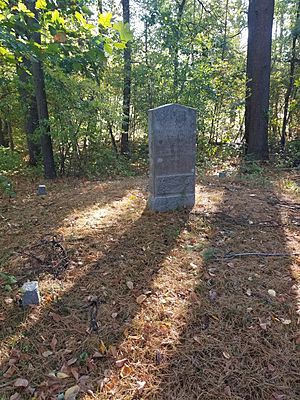John Kettell facts for kids
John Kettell (born around 1639) was an early settler in Massachusetts. He was also known as John Kettle. He worked as a cooper, which means he made barrels. Kettell was one of the first people to settle in the areas we now call Maynard, Massachusetts and Stow, Massachusetts. In 1676, during a conflict called King Philips War, Kettell's family was taken captive by Native Americans.
Contents
John Kettell's Early Life and Family
John Kettell was born in Charlestown, Massachusetts. He was baptized there in December 1639. His father, Richard Kettle, was also a cooper. John had several brothers and sisters, including Nathaniel, Joseph, Jonathan, Samuel, and Hannah.
John Kettell first married Sarah Goodnow. She was the daughter of Edmund Goodnow from Sudbury, Massachusetts. John and Sarah had three children: John, Sarah, and Joseph. After Sarah passed away, John married Elizabeth Ward from Ipswich. They had more children together, including Jonathan.
Settling in New Lands
Around 1660, John Kettell and another settler named Matthew Boon moved into new territory. They were the very first settlers in the area that later became Stow and Maynard. Kettell likely lived near Pompassiticutt Hill. This area is now part of Maynard. However, some people believe he lived closer to where his monument stands today.
By 1663, Kettell was also spending a lot of time in Portsmouth, New Hampshire.
The King Philip's War Incident
During King Philip's War in 1676, there are different stories about what happened to the Kettell family. Some accounts say the Kettells went to Rowlandson's fort for safety. In these stories, John Kettell and his sons, John and Joseph, were killed during an attack on the fort.
Other accounts say John's wife, Elizabeth, and children, Sarah, Jonathan, and another daughter, were taken captive. They were later set free, just like Mary Rowlandson. Two other daughters supposedly escaped to Marlborough after almost starving.
The Kettell Monument
In 1883, a man named John Robbins gave land to the town of Stow. This land was near an old cellar. People believed this cellar was where Kettell once lived. It was about a quarter-mile from the Bolton town line.
Today, there is a large granite monument in Stow. It is located on Stiles Farm Road, off Maple Road. This monument was placed in 1883. It honors John Kettell and his family. It mentions that they "escaped" to the Lancaster fort during the Native American raids. There is a public path to visit this monument.
Different Ideas About John Kettell's Death
There is some disagreement about how and when John Kettell died. The monument says he was killed during the Native American raids. However, some historians believe this is not accurate.
Historian Rev. George F. Clark said that the story of Kettell being captured and killed by Native Americans is "doubtful." Clark believed John Kettell likely died at sea around 1690. He thought Kettell spent much of his later life working as a cooper in Portsmouth, New Hampshire. Clark found old records, like probate and tax documents, to support his idea.
Clark also pointed to a letter from a Native American scribe named James Printer. This letter was sent to Kettell to discuss the release of Kettell's family. This suggests that John Kettell was alive for some time after the Lancaster raid.
Clark also questioned if John Kettell owned the land in Stow where his monument is. However, he agreed that Kettell did live in the general area for a while. He might have lived on a farm owned by Abraham Joslin. Several Joslin family members were also killed or taken captive in the Lancaster raid.
In 1675-1676, just after the Lancaster raid, Kettell was working in New Castle, N.H.. He also gave a statement in Exeter in 1678. In this statement, he said he was about 38 years old. This age matches the birth date of John Kettell from Charlestown. Later, in 1720-1721, John's brother, Nathaniel Kettell, asked for John's estate to be valued. He stated that his brother had disappeared at sea about 30 years earlier.
There was a big debate in the 1890s between Rev. George F. Clark and Abraham G.R. Hale. They argued about how to use historical information. Clark believed in using original documents, while Hale relied more on local traditions. Their main topic for this debate was the life and death of John Kettell and the accuracy of his monument.
Remembering John Kettell
Besides the monument, John Kettell's name is remembered in other ways. In Stow, you can find Kettell Plain Road and the Kettell Farm Conservation Property.







